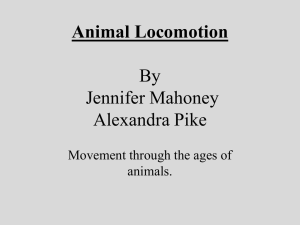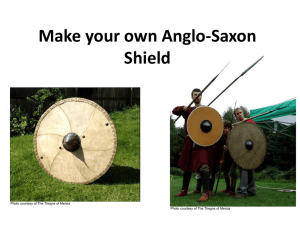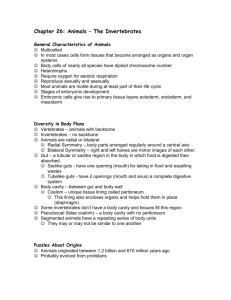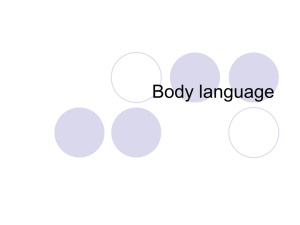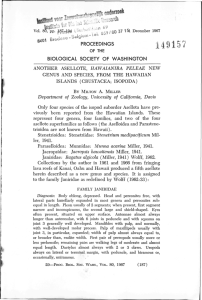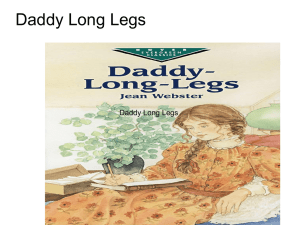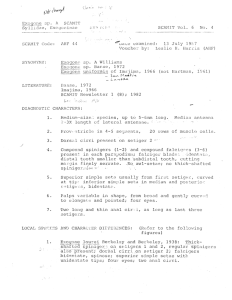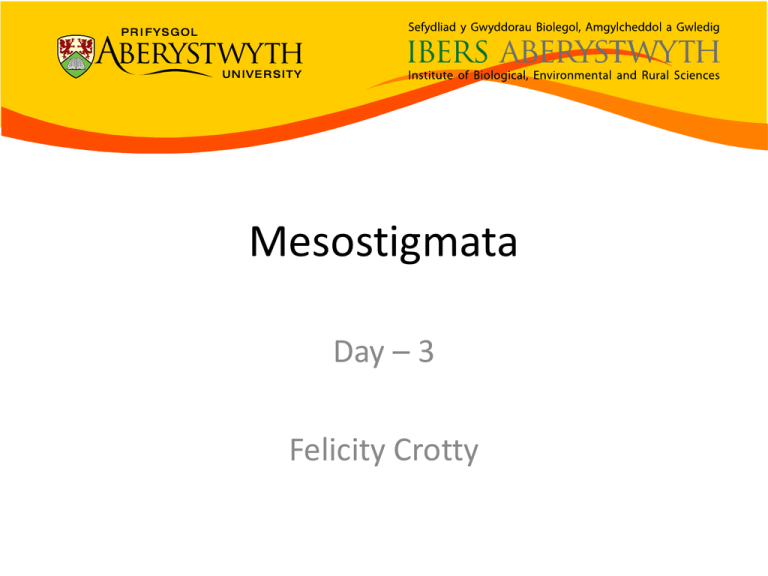
Mesostigmata
Day – 3
Felicity Crotty
Mesostigmata
Sejida
Trigynaspida
Cercomegistina
Monogynaspida
Antennophorina
Heatherelina
Microgyniina
Heterozerconina
Uropodina
Gamasina
3 Suborders; One main Suborder with 5 Cohorts
6
SEGMENTED
LEGS
Leg segmentation
Tarsus IV ventral setae av4/pv4 on
sclerite between basi and
telotarsus a key diagnostic feature!
If present =
Sejida or
Trigynaspida
If absent =
Monogynaspida
Generalised venter
•
•
•
•
•
St = sternal shield
Ep = epigynal shield
V = ventral shield
An = anal shield
Mst = metasternal
shields
• Trt = tritiosternum
Hypostomal setae
If linear =
Uropodina
If triangular =
other cohorts
within
monogynaspida
Uropodid
Bingo I.D
character
Pedofossa:
recesses
into which
legs can be
withdrawn
Epicriina
Bingo I.D character
Dorsal shield entire,
covered with polygonal
network of tubercles
Also identifiers include first
pair of setae on small
platelets.
Parasitina
Shield character I.D
Apex of epigynal shield
triangular and flanked by
large metasternal shield
bearing metasternal setae
Dermanyssina Shields
Oribatida
Day – 3
Felicity Crotty
Oribatida
Desmonomata
Enarthronota
Paleosomata
Mixonomata
Parhyposomata
Nothrina
Brachypylina
Astigmata
“Lower Oribatids”
Macropyline
5 Supercohorts; One with three cohorts
“Higher Oribatids”
Brachypyline
Defining characters of the 6 major
Oribatid groups
Character
Palaeosomata
Enarthronota
Parhyposomata
Mixonomata
Desmonomata
& Brachypylina
Body
Sclerotisation
weak
Weak to
strong
Weak to strong
Weak to strong
Strong
Prodorsum
type
Astegasime
Steg /
astegasime
Steg /
astegasime
Steg /
astegasime
Stegasime
Body type
Dichoid
Dichoid /
ptychoid
Dichoid /
trichoid
Dichoid /
ptychoid
Holoid
Notogastral
Scissures
Absent or
poorly defined
Present (1-3)
Present (1)
None
None
Femur
Divided
fused
Fused
Fused
Fused
Opisthosomal
Gland
Absent
Absent
Present
Present (or
secondarily
lost)
Present
Body type
Subcapitulum
Body appears to be divided between legs II-III by a flexible
sejugal furrow
Body type
Lacks flexible
sejugal furrow
Box mites
3 segments
Body type
Fused
coxisternum
Postpedal furrow
Pygidium
Circumgastric scissure
Pronotaspis
Body type
1
2
3
View if
Oribatid on
it’s back
STENARTHRIC
ANARTHRIC
ANARTHRIC
DIARTHRIC
PELOPSIFORM
ATTENUATEEDENTATE
Gnathosoma
Trichobothria
First step to identification
is it…?
Lower Oribatid - Macropyline
• Genua of all legs similar to tibiae in size and
shape (not knee-like)
• Leg articulation not in deep acetabula
• Trochanters I and II small but clearly external.
• Paired aggenital and adanal plates often
distinguishable
• Coxisternal region often transversely divided
by sejugal articulation
• Subcaptiulum usually stenarthric
Higher Oribatid – Brachypyline
• Genua of legs I-III (& often IV) shorter than tibiae
and lacking intrinsic musculature – KNEE
• Holoid body type
• Distinct acetubula with trochanters I and II almost
totally contained within
• Apodemato-acetabular system of tracheae
• Brachypyline venter unified rigid plate
• Often evolved chelicerae & subcapitulum modified
- diarthric
Acetabulum is a
concave cavity in the
body wall where a
leg is inserted; in
brachypyline
oribatids these
cavities are where
the trochanter
articulates with the
coxae (fused to body
wall) and may
contain tracheal
stigmata
Genua knee like
Examples of different Oribatids
Numbers relate to
susceptibility to
degraded
environments
(5 = very
susceptible)
Aoki 1996
Astigmata
•
•
•
•
Cohort of Oribatida (in Desmonomata currently)
Weakly sclerotized (white / pale)
Slow moving
Lack respiratory stigmata or tracheae (respire
through cuticle)
• Lack segmentation
• Body divided into 2 main regions gnathosoma
and idiosoma (separated by sejugal furrow)
Astigmata
Astigmata
•
•
•
•
•
Palps ONLY 2 segmented
Chelicerae are chelate-dentate (3)
Have two genital papillae (4)
Male has aedeagus (4)
Anal opening often flanked by
copulatory suckers (6)
• A claw at apex of tarsus attached
to a fleshy pretarsus, supported
by sclerotised condylophores (7)
Astigmata biology
• Complete life cycle in several
days to weeks
• Lay up to 800 eggs in a month!
• Adult average longevity 23-46
days
• Have an unusual heteromorphic
deutonymphal (often phoretic)
• Hypopus – highly resistant to
adverse environmental
conditions. Lacks mouthparts,
often has suckerplate
Most important soil genera
•
•
•
•
•
•
Tyrophagus
Schwiebea
Rhizoglyphus
Glycyphagus
Lepidoglyphus
Histiostoma
Once you are certain it is
an Astigmatid mite, it is
very easy to identify to
family using Dindal key!
If you are feeling
adventurous, you can also
key to genera!
Prostigmata
Day – 3
Felicity Crotty
Prostigmata
Eupodides
Anystides
Eleutherengonides
Labidostommatides
Anystina
Parasitengonina
Raphignathina Heterostigmata
4 Supercohorts; two of which have 2 cohorts within them
Comparative Characters Prostigmata
Eupodina
Anystid
Parasitengona
Raphignathae Heterostigmata
Palp
segments
4
5
5
5
3 max
Palp tibia
Linear
Thumb claw
Thumb claw
Thumb claw
No
stigmata
Base of
chelicera
Base of
chelicera
Absent
Base of
chelicera
Anterior lateral on
propodorsoma F
Peritremes
No
Yes
No
Yes
No
Naso
Yes
Yes
Yes
No
No
Pairs of
trichobothria
1,2
1
1,2
0
0 imm; 1 F; 0 M
Empodial
tenant hairs
No
No
No
Yes
No (II, III
membraneous)
Trichobothria
Eye
Dorso-sejugal
Suture not distinct
Dorso-sejugal
suture
Genital papillae
Endeostig
Prostig
Examples of palp thumbclaw
Peritremes
Stigmata
Two different naming systems!
Same
segmentation
on palp
5 free leg
segments
Coxa fused
to ventral
idiosoma
Paired claws and empodium
Paired claws
Solenidia
Different types of setae and
Trichobothria (arrow)
Famulus
If Solenidia is supposed
to be “Recumbent”, it is
lying down alongside leg
Duplex setae: Normal
setae alongside a
Solenidia
Labidostomatidae
• 1 family
• Medium to large sclerotized mites
• “Arnie” mite – look like it has a 6
pack! – Coxal fields expanded
• 2 pairs prodorsal trichobothria
• Palps linear
• Cheliceral bases separate, digits
enlarged and chelate-dentate
• Legs I tactile; legs II-IV walking
• Predator
Parasitengona
• Members of this group are
well known to nonacarologists as velvet
mites!
• Red or green
• Stigmata & peritremes
located between cheliceral
bases
• Palp thumbclaw well
developed
• 1 or 2 prodorsal
trichobothria
• Genital papillae usually
present
Heterostigmata
•
•
•
•
Very common
Minute to medium sized
Capitulum head-like
Palps linear and reduced to 3 or
fewer segments
• F: stigmata anterolaterally (on
shoulders) of prodorsum.
• Legs I often with tarsal claw as
modified hook
• F: legs IV often reduced or absent
Major character systems in
Prostigmata
• Chelicerae modified e.g. fused together /
subcapitulum; reduction of fixed digit
(Prostigmata are mainly fluid feeders)
• Modification of the palp
• Body setation
• Leg setation
• Modification of the pretarsus
Acknowledgments
Soil Mite Experts
Cal Welbourne
Valerie Behan-Pelletier
Roy Norton
David Walter

